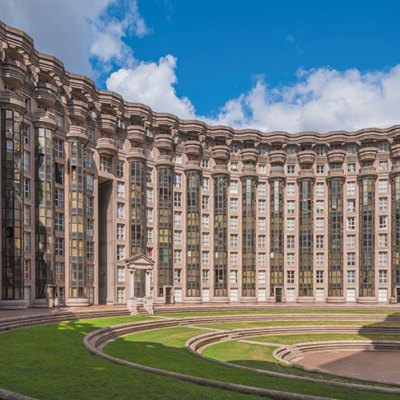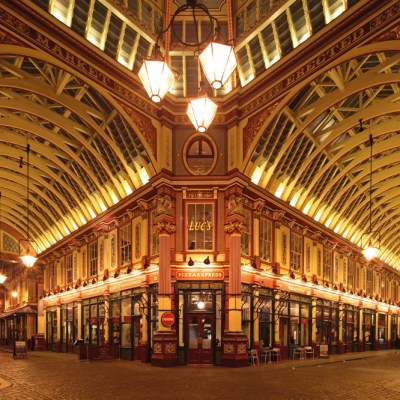A new and beautifully illustrated book on Henbury Hall by the architectural historian Jeremy Musson, full of wonderful photography, drawings, letters and portraits, raises the old question of the ‘problem’ building, the one that most writers and critics find hard to discuss. For Henbury, near Macclesfield in Cheshire, is the 1980s progeny of Andrea Palladio’s Villa Rotunda outside Vicenza, and was designed for the late engineer and industrialist Sebastian de Ferranti by the young architect Julian Bicknell and based on a capriccio by Felix Kelly.
Henbury’s dome, its cool buttery limestone facades, its tetrastyle porticoes and its landscaped setting, which includes a geometrical garden planted with olive trees and decorated with an artfully placed antique barley-sugar column and obelisk, suggest a literal translation of the Veneto to a very different landscape. But in fact the architectural detail of the house is English in character, especially internally, and this makes it all the more remarkable. The front door leads from ground level into a lower hall, rather than from the top of a grand flight of stairs into a first-floor saloon; after considerable experiment Bicknell and De Ferranti chose to link this hall to the upper storeys with a relatively small oval staircase that opens up unexpectedly to one side. This narrowing of the entrance route makes the revelation of the great central hall on the piano nobile all the more unexpected, and exciting. None of that has Palladian origins. Nor does the exceptionally fine detail of the Kentian overdoor carvings that adorn the house. The lift is Brighton-Pavilion Chinese; the top-most storey is Soaneian. The overall dimensions of the house are actually quite small, with corner rooms scarcely bigger than 15 square metres in area (Bicknell’s working drawings are helpfully included in Musson’s book), and even the central hall is less than five and half metres wide. So the effect within the house is intense, and the views when inside between doors and windows are immediate and rich. Decorated ceilings, such as Hazel Morgan’s mural in the morning room, in which classical figures peer downwards through an oval frame, add a further dimension to the experience.
The south end of the hall, looking out to the park, which was landscaped in the late 18th and 19th centuries. Photo: © Cally Stockdale

What can be made of all this? Had Bicknell ‘interpreted’ Palladian architecture in the way deemed acceptable at the time, rather than drawing directly on authentic classical themes, the house would have looked like an amusing or eerie 1970s building. In fact De Ferranti had earlier invited John Taylor, of the large and successful commercial practice Chapman Taylor, to design him a villa, and what Taylor came up with was precisely one of these ‘interpretations’. It was, like Taylor’s own new castle in Wales, an interesting example of its kind. But De Ferranti wanted the real thing, and Bicknell, who had recently worked on and at Castle Howard, drew on Vanbrugh’s Temple of the Four Winds as much as on Palladio himself to perfect his design.
Back in June Tanvir Hasan, the director of the London office of Donald Insall Associates, probably the world’s leading conservation practice, hosted a public discussion in which I participated about the contemporary use of architectural style. One of our themes was that young designers in architecture schools are beginning to show an astonishing thirst for knowledge about how and why old buildings look the way they do, and for the detailed and technical terminology to describe them. Only now are the tutors in these schools beginning to respond to this, and it is mainly the younger ones who do. I was a student at the time Henbury was designed, and to say that discussion of that type of architecture was beyond the pale would be an understatement. In fact, any reference to any historical building at all was considered an outrage, and this in Cambridge, full of wonderful buildings of all periods. James Stevens Curl’s recent Making Dystopia explains how the bizarre situation came about in which a small clique of modernists managed to effect a deathly grip on architecture schools worldwide that persisted for decades. This is not to say that architects should not experiment; it is to say that something was badly wrong with an educational curriculum full of prohibitions and taboos mostly invented more than half a century earlier.
This situation left critics and young architects without the vocabulary, let alone the historical knowledge, to assess a house like Henbury, which became a problem building. This line of thought was supported by the fact that much classical building at that time was debatable in terms of quality: it was enough for a critic to point at, say, a disappointing house by Quinlan Terry and announce ‘I told you so’. However, for the most part one sees the significance of a point that Curl is making: the modernists with a grip on architectural education had limited design ability themselves, and kept returning the debate to one about intellectual concepts because it was only from there that they could dominate the discussion. A further problem was the conflation of historical reference with what was seen as mimicry: I don’t remember hearing a single discussion during the 20 years from 1980 that distinguished the two.
At the end of a long period of researching and writing about Edwardian domestic architecture I have concluded that it was the high level of analysis in the professional and scholarly press of Tudor architecture, its components and its various historical and symbolic meanings, that generated buildings of the highest quality and absolutely of their own era. You should not have to be a conservative by nature or indeed particularly to like classical architecture to see that Henbury Hall is superbly designed and made, created by people who cared strongly about its references and details; and by definition it is at least as much a building of its time, almost four decades back, as any of the more critically fashionable houses of the period – if anyone can remember what those actually were.
From the October 2019 issue of Apollo. Preview the current issue and subscribe here.



